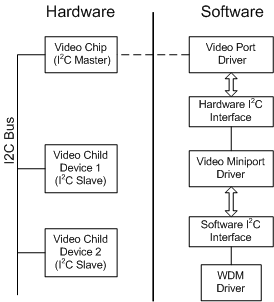Using I2C to Communicate with a Child Device
On Windows XP and later, after the Plug and Play manager has enumerated a video adapter's child devices, the miniport driver can communicate with the adapter's child devices on an I2C bus using the I²C protocol. Communication between the miniport driver and WDM drivers for those devices on an I²C bus can occur via a software interface exposed by the miniport driver (as described in Communicating with the Driver of a Child Device). The miniport driver can initiate physical communication between those devices on the I²C bus by way of a new hardware interface exposed by the video port driver. If the miniport driver needs the I²C master device (usually the graphics chip) to read from or write to a physical child device over the I²C bus, it can use the hardware I²C interface provided by the video port driver's VideoPortQueryServices routine. Note that this communication over the I²C bus is limited strictly to hardware devices on the same I²C bus. Miniport driver writers are strongly encouraged to use these routines for all such communication.
This mode of communication is also useful in cases where a video adapter has components for which there is no WDM driver. For example, a video adapter may have a daughter board or circuit that is used to send the video image to a digital flat panel. In this case, the miniport driver can make use of the hardware I²C interface provided by VideoPortQueryServices to send commands to that circuit over the I²C bus.

The preceding figure illustrates how a miniport driver can initiate communication between two hardware devices on an I²C bus.
To take advantage of the video port's I²C routines, the miniport driver must query the video port driver for an I²C interface. In preparation for this, the miniport driver must allocate a VIDEO_PORT_I2C_INTERFACE structure, and initialize its first two members (the Size and Version members) to appropriate values. The miniport driver then calls the video port driver's VideoPortQueryServices routine, setting the servicesType parameter to VideoPortServicesI2C, and setting the pInterface parameter to the partially-initialized VIDEO_PORT_I2C_INTERFACE structure.
If the call to VideoPortQueryServices is successful, the video port driver fills in the remaining members of the VIDEO_PORT_I2C_INTERFACE structure, including the addresses of four I²C routines: I2CStart, I2CStop, I2CRead, and I2CWrite.
I2CStart and I2CStop are used, respectively, to initiate communication with the child device, and to terminate communication with it.
I2CRead reads a specified number of bytes from the child device; I2CWrite writes a specified number of bytes to it.
Feedback
Coming soon: Throughout 2024 we will be phasing out GitHub Issues as the feedback mechanism for content and replacing it with a new feedback system. For more information see: https://aka.ms/ContentUserFeedback.
Submit and view feedback for